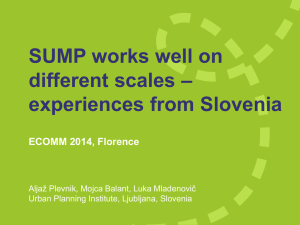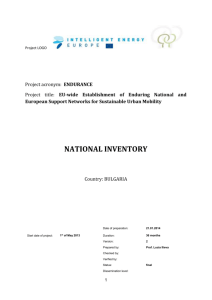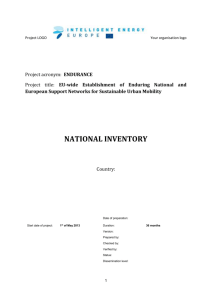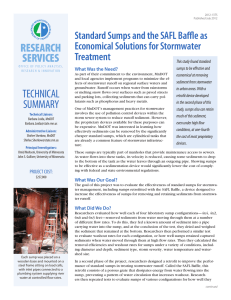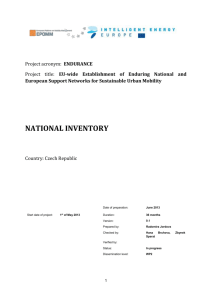Presentation SUMP
advertisement
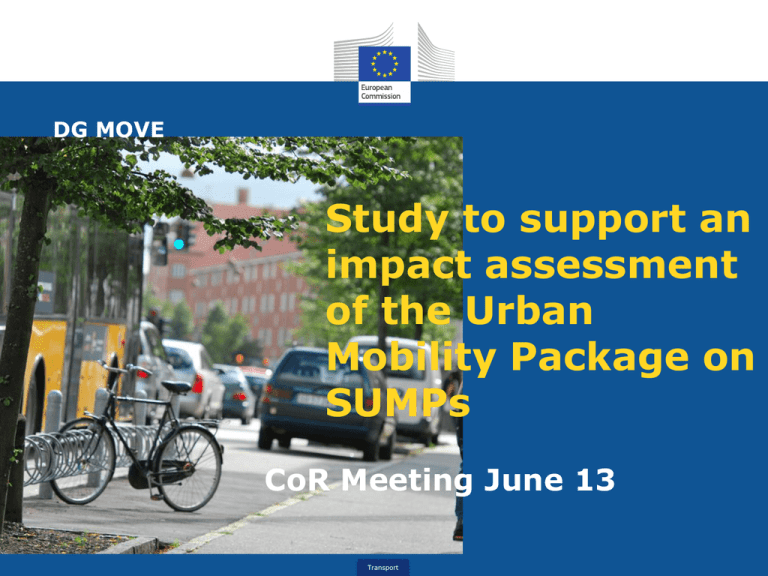
DG MOVE Study to support an impact assessment of the Urban Mobility Package on SUMPs CoR Meeting June 13 Transport Structure • Public consultation • Impact Assessment • Questions Transport Public Consultation: SUMPs • A vast majority of respondents (87%) think that there is a lack of coordination between authorities and other actors and that integrated urban mobility planning could be an answer to tackle this issue. • A vast majority of respondents (91%) agree that integrated urban mobility planning is a useful tool for promoting coordination at local and regional levels • A vast majority of respondents (86%) see that EU-support for the development of Sustainable Urban Mobility Plans (SUMPs) would contribute to the broader take-up of SUMP in urban areas Transport Which support should be provided at EU level to facilitate the development of Sustainable Urban Mobility Plans? 0% 10% Development and exchange of best practices on SUMP Provide a platform for cities to exchange best practice Financial support for the development of SUMP Support R&D projects on urban mobility planning Development of guidelines and recommendations Support for professional training activities and staff exchange Definition of the minimum scope and content of SUMP Mandatory development of SUMP for all cities in the EU Mandatory development of SUMP for cities in certain situations Transport 20% 30% 40% 50% 60% 70% 80% Topics to be addressed by SUMP 0% 10% Walking and cycling Public Transport Plan Integration of transport and mobility services Urban logistics Coherence with urban development and land-use planning Access Restriction Schemes Parking management Coherence with transport plans at regional, national and EU level Accessibility; social inclusion; demographic change Safety and security Procedures for impact or process evaluation; monitoring Procedures for citizen and stakeholder engagement School mobility plans Car sharing and carpooling facilities Investment, financing, public private partnerships Corporate mobility management plans Transport 20% 30% 40% 50% 60% 70% 80% Public Consultation: SUMPs and EU funding of urban transport projects • A majority of respondents (67%) are in favour of linking the access to EU funding for urban transport projects to the existence of Sustainable Urban Mobility Plans (SUMPs) in order to provide a safeguard that supported projects are in line with relevant local, national and EU policies. • Almost 60% of the respondents would like to see financial support for development of SUMPs Transport Impact Assessment on SUMPs I Problem • Overall: the urban transport systems in EU are not competitive and resource efficient • Specific: not meeting EU objectives, such as on road safety, GHG, air quality, noise Solution to the problem • More integrated urban mobility approach in the form of sustainable urban mobility plans Status on integrated urban mobility approach • European cities are on the move towards SUMP • Not black or white - few if any of the cities implement ‘perfect’ SUMP-practices while almost all cities do something • Cities in new member states are generally less advanced in SUMP-planning Transport Impact Assessment on SUMPs II How to move forward? Define what a "benchmark" concept for an integrated urban mobility approach should include Define alternative policy options • Elements included in the SUMP (level of ambition) • Type of instrument • Size of cities to be covered Assess and compare alternative policy options Transport Impact Assessment on SUMPs III What should a benchmark concept for an integrated urban mobility approach include? Content and scope • Minimum requirements • Comprehensive requirements Process and procedures • Minimum requirements • Comprehensive requirements Transport Impact Assessment on SUMPs IV • Minimum Requirements on content and scope: • • • Addresses both freight and passenger transport Addresses all transport modes Addresses the following topics: • public transport services • non-motorised transport • city logistics • mobility management • integration of transport modes (multi-modality) • the road network and motorised transport (including moving and stationary traffic) Horizontal integration of road safety, ITS, mobility for all in topics Transport Impact Assessment on SUMPs V • Comprehensive Requirements on content and scope: • • • Address the following "promising" measures and instruments: • low emission zones • urban road user charging/congestion charging • parking pricing • public transport pricing Introduction of clean technologies and alternative fuels Ensures interoperability and/or consistency in use of instruments across the EU Transport Impact Assessment on SUMPs VI • Minimum Requirements on processes and procedures: • Contains pledge to sustainability (economic, social and environmental) • Includes or is built on long-term strategy • Identifies objectives and sets targets in line with EU policy objectives • Includes baseline (reference) analysis including performance audit of present situation • Includes impact assessment on proposed measures • Provides short-term implementation plan (timetable and budget plan; allocation of responsibilities) • Considers all transport to, through and within the urban agglomeration area and coordination between different authority levels Transport Impact Assessment on SUMPs VII • Minimum Requirements on processes and procedures: • Is developed in a participatory approach • Integrates different relevant policy areas, in particular land use and transport planning • Is based on integrated planning and implementation • Includes mechanisms for monitoring of the performance in the Member States • Include mechanisms for review in the Member States • Includes mechanisms for certification in the Member States Transport Impact Assessment on SUMPs VIII • Comprehensive Requirements on processes and procedures: • Identifies objectives and sets targets in line with EU policy objectives, including mandatory targets on urban mobility performance • Foresees mechanisms for monitoring at EU level • Foresees mechanisms for review at EU level • Is certified by an independent body at EU level Transport Impact Assessment on SUMPs IX • Policy options: • 1. The existing programmes continue to provide • exchange of best practises • information sharing platform • funding of pilot projects and SUMP development • awareness raising • training Transport Impact Assessment on SUMPs X • Policy options: • 2. Recommendations (3 alternatives) • Recommendations by the EU for a SUMP framework (based on the comprehensive elements), • Recommendations, but adding voluntary benchmarking of urban mobility performance, • Recommendations, but adding a requirement to do a SUMP as a condition for receiving EU funding for urban transport projects. Transport Impact Assessment on SUMPs XI • Policy options: • 3. Framework directive (2 alternatives) • A mandatory SUMP framework based on the minimum requirements on content and scope • A mandatory SUMP framework based on the comprehensive requirements on content and scope. • For each alternative: 4 alternative coverage definitions: • • • • MS decide on city size in line with reaching EU objectives cities with more 100,000 inhabitants cities with more 250,000 inhabitants cities with more 1,000,000 inhabitants and capitals (TEN-T urban nodes) Transport Questions for debate on SUMPs • What support should be provided at EU level to facilitate the development and implementation of SUMPs in the MS? • Would linking the access to EU funding for urban transport projects to the existence of SUMPs provide a safeguard that supported projects are in line with relevant local, national and EU policy objectives? • • What is your opinion of the different policy options in the Impact Assessment? • What is your opinion about the potential advantages and disadvantages of the alternative policy options? Transport
